Last week I was in the backseat of a shuddering Matamoras taxi driven by a man named Jesus. My mission was to know and prove the place and time of death of a CEO on the border between Mexico and Texas.
I got to know Jesus well over two days. By the time we said adios we had crossed the Rio Bravo (or Rio Grande) five times, disproved death (she was alive and well in Reynosa) and honed his plan to get rich.
Jesus was going to Alaska for 12 weeks not just to do one of the few jobs riskier than drive gringos finding folks who don’t want to be found. He reckons he can make $30,000, get in line for 1-10 per cent boat profit, and spend less than two grand by living hard.
“Then I can fix my car, man.” It did need a fix, but I was not sure salmon was a solution.
“How cold have you ever been?
He shrugged.
“You better spend another thousand on long johns, silk briefs, wool hats, and the best damn gloves you can get. Stay out of the bars. And don’t get in a fight, man. Lay low.”
He nodded.
Deep sea deck hands, even novices, off Alaska can make $5-6,000 each three-week trip plus a percentage of the catch. Crab season has been cancelled in the Bering Straits because of a million crabs going missing, making other catches even more lucrative.
But 500 fishermen die each decade on American waters with Alaska the grim leader: reaper of a quarter of the total mortality. Falling overboard is a common cause; the rogue wave comes out of the blue.
A workday is 20 hours and sleep is never deep. There will be storms to ride out; most deaths feature “vessel instability” and many others come from a leak.
All that health from eating salmon is won by hazards which include the highest rate of lost fingers, hearing loss, and rotator cuff injuries of any occupation studied by the U.S. Department of Labour.
On the way to the airport, I began to think about wingers, or wings. Our rugby deep sea fishermen. Out there in the cold, looking for work, less connected to the core actions of the team than any other player, and fascinated with keeping dry and clean.
But they bank. Wings get rich from scoring from deep. Nine of the top 10 try-scorers in Test rugby are wings. In fact, if you do not score tries as a wing, you are not a good wing. This is the only position of which we can say that. Fishermen catch fish: wings hope to eat steak and stout pies, or chicken and leek.
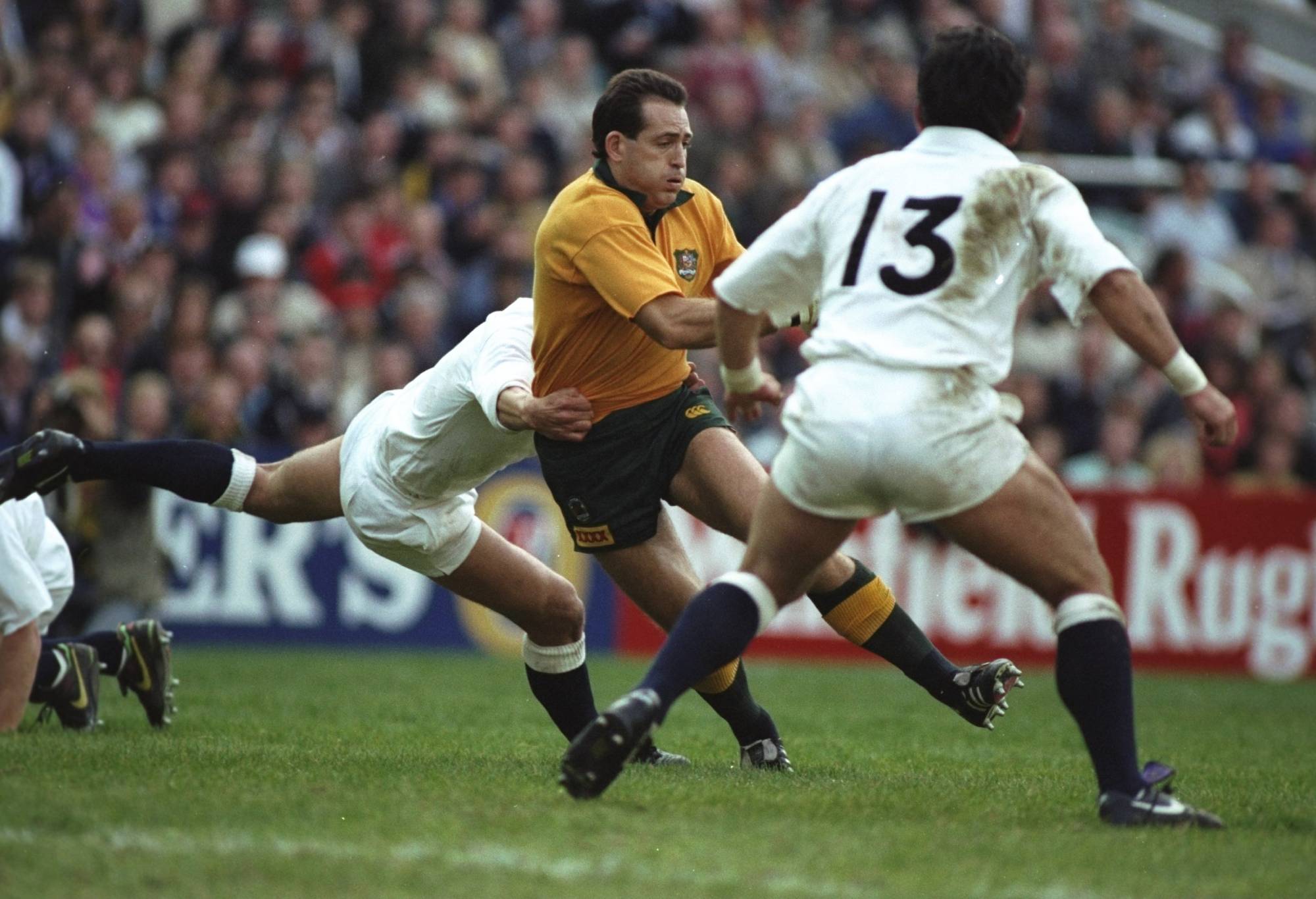
David Campese remains the prince of wingers. (Credit: Russell Cheyne/Allsport)
They are the angels of the rugby club. They guard the outer gates of the goal line, thrust through and around defences themselves, and whilst their collisions sound like a wave on the deck, they look good.
Ange Capuozzo almost singlehandedly brought Rome to its knees in adulation as he flew about the field.
If my rugby movie ever gets made, the wings will be named Michael, Gabriel, Raphael, and Campese.
If any rugby position in our series has less of a template for size and shape, it may be these speedsters. If coltish Damian Penaud, blocklike Caleb Clarke, hardman Marika Koroibete, youth minister Will Jordan, boy band Louis Rees-Zammit, and tiny Kurt-Lee Arendse arrived at a training pitch on the first day of preseason, the equipment manager would need more information to hand out gear.
They have to be fast. They are better if fast. Because their chances are fleeting, and they must finish: get the ball down in tiny spaces, and jar the ball or man loose on the other end. Speed is as crucial for a wing as rubber boots for the deck hand.
Kick chase for sprinters like Makazole Mapimpi go on for the full 80 and rush defence rests on their ability not to produce or ignore lactic acid.
But you can be fast in many different sizes.
Big men who can motor have fished out wide. Jonah Lomu could traverse a hundred metres in less than 11 seconds on a grass pitch holding a ball but he shaped like a No. 8. Giant George North started at wing, Julian Savea bussed the trams, the Bua Bullet Rupeni Caucaunibuca was shaped like a prop, Joe Rokocoko could have been the world’s fastest blindside, angel-loving Israel Folau always won his aerial battles on the wing, and ‘Jock Bok’ Duhan van der Merwe is just a bit shy of Lomu-esque stature as the Afrikaner Android.
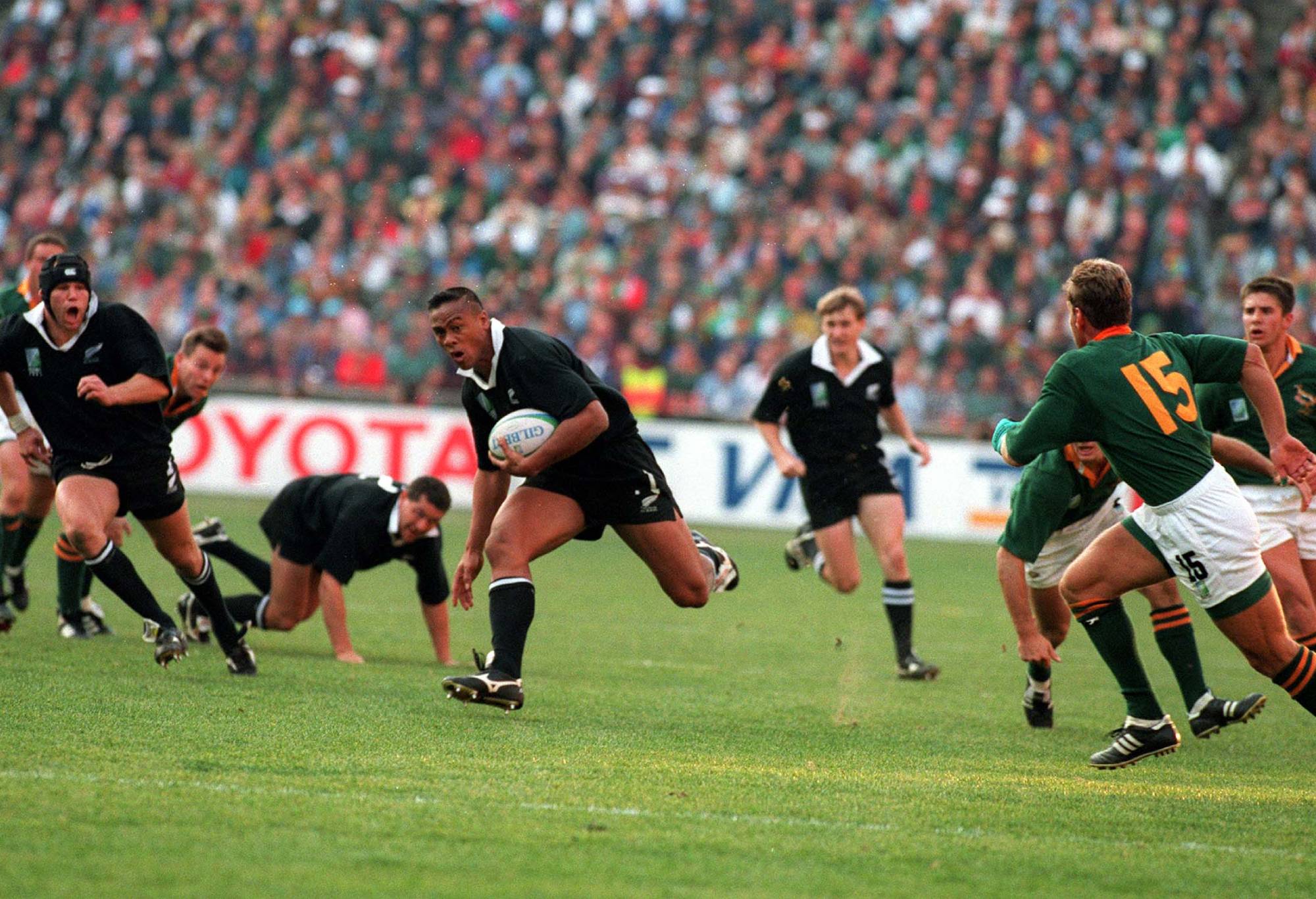
Top Aussies (and good fellows both) Chris Latham and Joe Roff both stand about six foot four, and are part of a significant portion of 11s and 14s who could also play 15 (Israel Dagg being a good example of a fullback-wing and Christian Cullen a wing-fullback).
Big ‘full-wing’ Lote Tuqiri won 51 caps of his caps on the wing and scored 10 Test tries in a season. To defuse bombs, many teams essentially play two fullbacks in the back three. Phenom Serge Blanco from old and Pumas kicker Emiliano Boffelli now are preserving that tradition.
Some speedsters are ‘normal’ sized: goose-stepping David Campese, one of history’s great ones, lightning quick Doug Howlett, cricket-rugby star Jeff Wilson, Ben ‘from Accounting’ Smith, the side-stepping Jason ‘Billy Whizz’ Robinson, stars-turned-commentators Bryan Habana and Drew Mitchell, legend Bryan ‘BeeGee’ Williams had massive legs but would not stick out today, and one of the best Springbok wings ever, Ray Mordt, he who scored a hat trick whilst flour bombs rained.
But now we are talking elite speed: Habana completed 40 metres in a time which translates to a 4.16 second 40 yards: faster than any tested in a century by the speed-obsessed NFL. Give Habana a sliver of space and he could take it to the line, slowing down at the end just to get you in his poster as he dove.
Speaking of doves and diving: wings make tries look better than any other. Leaping like salmon up the falls, sliding 10 yards as if in some Winter Olympic event yet to be invented, or just leaving tacklers in the dust.
There is the Ash Splash of Chris Ashton, developed over 100 Premiership tries with six clubs, in which the prolific scorer tried to dislocate his shoulder.
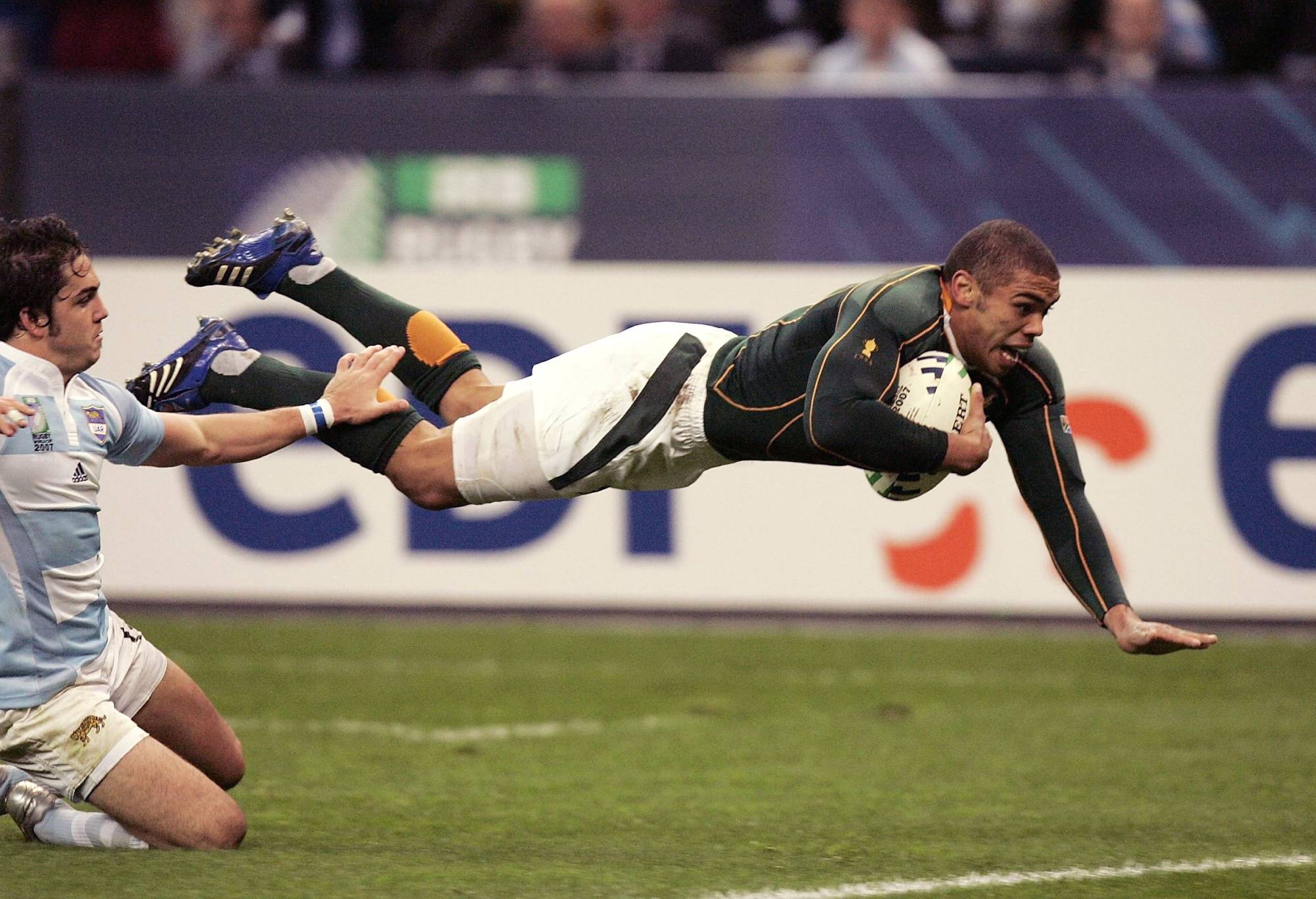
Bryan Habana remains one of rugby’s greatest ever players for his astonishing speed and finishing ability. (Photo by Tertius Pickard/Gallo Images/Getty Images)
Injuries are part of big contact, and some wings are very small. Spritely Rory Underwood scored 49 tries for England, agile Shane Williams scored over 1,000 points from Neath to Lions, Gerald Davies was slight, Cheslin Kolbe could step a ballroom dancer in a phone booth, Daisuke Ohata of Japan scored 69 tries in 58 tests without bowling anyone over, and James Small always seemed to have a guardian angel watching over him when he kept Lomu from ever scoring against the Springboks.
When we had Eddie Jones on The Roar Rugby Podcast, he spoke of the need to score fast, not to need the ball too long to score, likely because it is too short a time to develop a high-phase clean-ruck style in a few months, but this means his choices in the back three are as crucial as his 9-10 combination.
One of Mark Nawaqanitawase, Jordan Petaia, Andy Muirhead, Corey Toole, Filipo Daugunu, Suliasi Vunivalu or Andrew Kellaway will be seeking those slivers of space against Fijian, Welsh, Pumas, or Poms, in order to find the corridors left by rush defence teams like South Africa or France or slide backlines like New Zealand (who have choices aplenty of their own at wing) in the knockouts.
Why only one? Bullet train Koroibete holds the John Eales Medal and seems sure to hold his place. The only time he looked out of place in 2022 was in Sydney trying to sky with Bok rookie Canan Moodie. This means Jones may look for a bit of size or 15-like skills in his right wing.
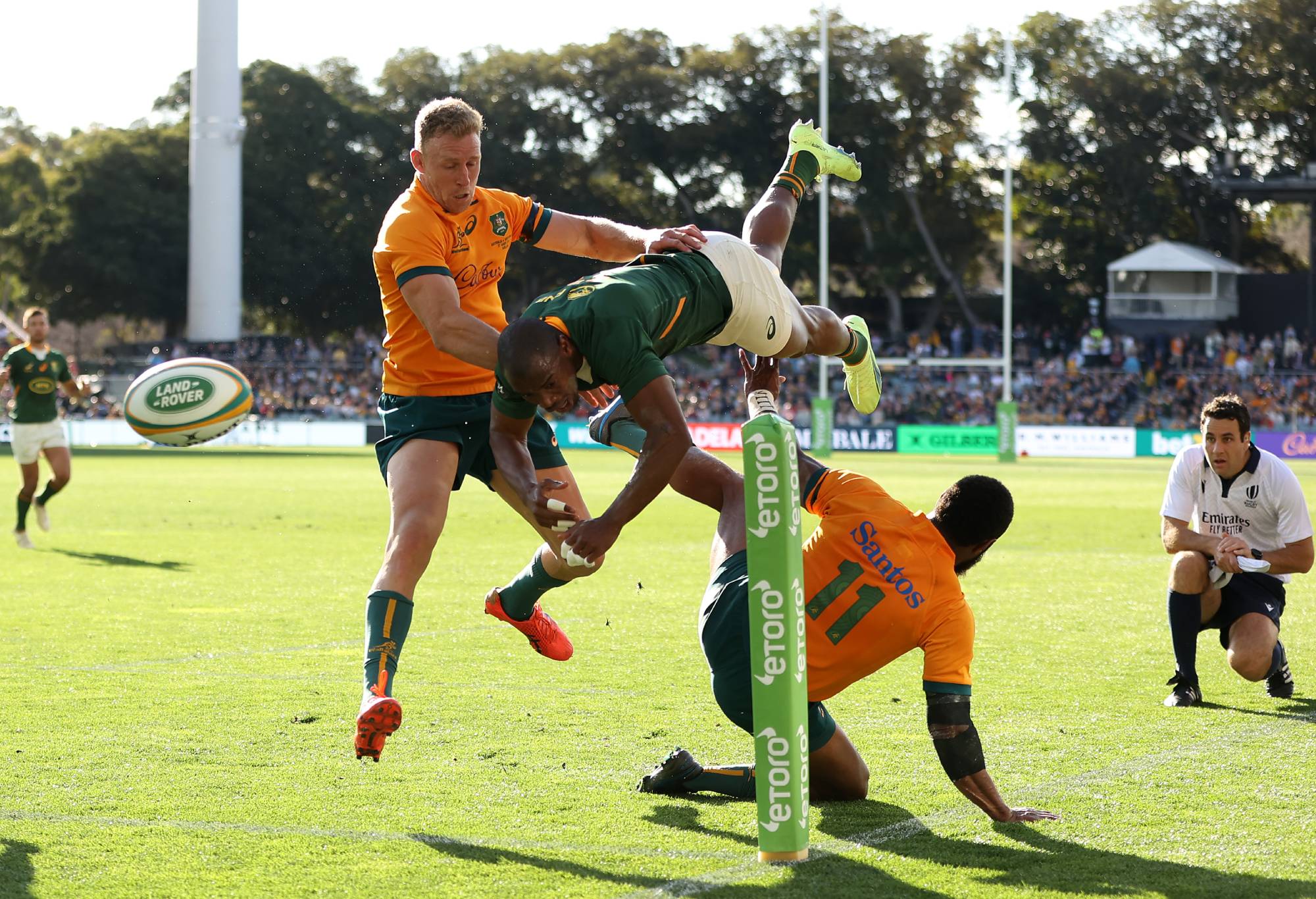
Makazole Mapimpi of the Springboks is tackled by Marika Koroibete in Adelaide. (Photo by Mark Kolbe/Getty Images)
There is less of a uniqueness between 11 and 14 than in any other position besides lock. Any fast, skilled wing can switch. In fact, Koroibete’s signature tackle of Mapimpi in Adelaide was on his right.
But Jones does need to consider balance when finding Koroibete’s twin wing.
There is big in the short list (Marky Mark, who can finish over contact, and deceptively large Petaia—as pointed out on our podcast by the other Jones—who can finish in contact, Vunivalu, who may just be finished), small and fast (lightly capped footballer Daugunu and uncapped Muirhead and Toole, surely not ready to field premium box kicks in a rainy French knockout?) and perhaps the most versatile Wallaby except for Reece Hodge, The Scots College bachelor, Australian Under-20 star, and 11-try wing for his country: Andrew Kellaway.
Perhaps Petaia’s destiny is utility back, which Jones featured as a vital cog in his smash-and-grab getaway car. A Koroibete-Kellaway wing combination provides an extra boot for the fullback (that is a mystery, too) and plenty of work rate on the deck.
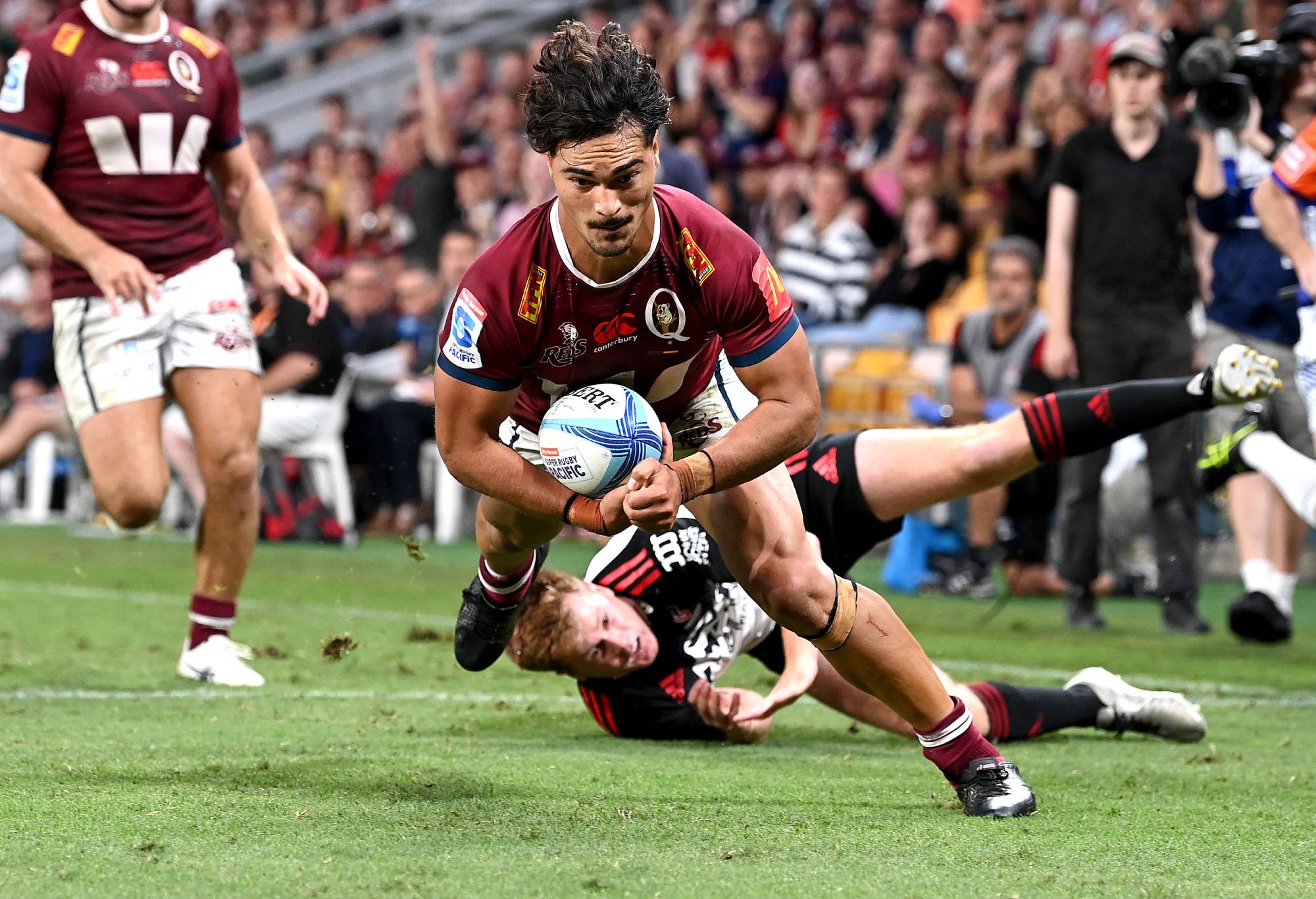
Wallabies utility back Jordan Petaia was having a brilliant season for the Reds before injuring his hand . (Photo by Bradley Kanaris/Getty Images)
A clue can be found in the 112 English players picked during the coaching era of Jones: clever but modest sized Elliot Daly was sixth-most capped with 57 (and 18 tries), whilst speedy hair-on-fire and unnuanced chaser Jonny May was ninth-most with 53 caps (and 29 tries). Daly-May’s 47-try haul was Peak Eddie’s England. Anthony Watson (36) and Jack Nowell (35) were next level down. Joe Cokanisiga (14) and Max Malins (14) were another notch lower. Since Eddie won 10 of 11 Tests against the Wallabies, he is likely to have points of difference in the back three from Messrs Cheika and Rennie in selection.
Jones has one of his easiest selections at 11; a true conundrum at 14, dependent on who his angels at 15 and player 23 are, but then that (the fullback) is the fishiest question of all, full-stop.
Jesus and Eddie will probably know how well they did in the North at about the same time: a fixed car or same as it was before.

































































































